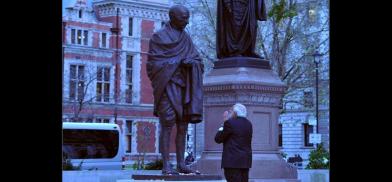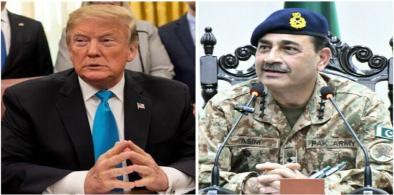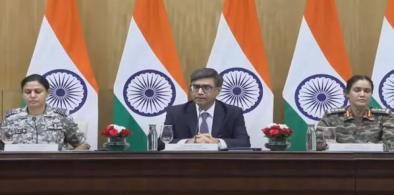He crossed boundaries for India's freedom: Musings at the feet of Gandhi in London
The statue has cost substantial money but is fully funded by the public through a charitable trust managed by a number of Indians residing in the UK. The chair of an advisory group that oversaw the project was former Pakistani-origin mayor and minister Sajid Javed.

Whenever I visit London, I simply cannot resist visiting Parliament Square, not far from the river Thames, where stands a statue of Mahatma Gandhi. I get into deep thoughts sitting at the feet of that amazing statue of Mahatma Gandhi - the last addition to the group of statues there - installed in 2015. The statues are placed directly looking towards the British Parliament as if they have a message to radiate towards that edifice of the democracy that witnessed all kinds of attempts to delay the decisions on giving freedoms to the countries colonised by the cruel guns and greed of wealth of the royal lords.
The statue of Gandhi is made from bronze by Scottish sculptor Philip Jackson who also sculpted Queen Elizabeth II. He designed the statue based on a photograph of Gandhi standing outside the offices of Prime Minister Ramsay MacDonald in 1931 during Gandhi’s visit to attend the Second RoundTable Conference ( Sept-December 1931). The photograph must have been taken at the onset of winter in England. Gandhi had a shawl around him, his hands clasped to trap the body heat. Gandhi wore a dhoti reaching below his knee.
The reasons for my utter obsession to visit the Square and spend my fresh mornings in the vicinity of the statue - before attending official meetings - are however more obscure. Three things make me wonder every time I sit on the ground near the statue.
Parliament Square where Gandhi’s statue stands hosts other ten statues including that of Nelson Mandela and Abraham Lincoln. It is also near to the statue of Wilson Churchill whose hatred towards Gandhi ran deep in his colonial veins. His spiteful words that framed Mahatma Gandhi were far from prime ministerial. “Malignant subversive fanatic” and “a seditious Middle Temple lawyer, now posing as a fakir of a type well known in the East, striding half-naked up the steps of the Viceregal palace”, make me drowned in historical and even current contrasts. Churchill even went on to say that " ( Gandhi) ought to have lain bound hand and foot at the gates of Delhi, and then trampled on by an enormous elephant."

Gandhi and Churchill
Though I despise such words, I also feel if such thoughts coming from him are natural given his upbringing in culturally dry and inhumanly regal barracks. What more one can expect from an imperialist with strikingly contrasting military training, from an aristocratic family and from the produce of a political dynastical lineage? The leader that led the army with guns and bombs to win the war stands there near another one that won the war without any arms and became apostles of peace. Now the statues of these two leaders stand in the same park facing the perennial flow of the Thames.
As compared to all other statues in Parliamentary Square, Gandhi’s statue is at a lower level almost at ground zero and accessible. Other statues are installed on a decorative high plinth and look unreachable. I can sit down near Gandhi’s statue and get lost in the thoughts as to how Gandhi really belonged to the people. He dressed like them, clasped like them, looked like them. He definitely did not look like one of those "Middle Temple lawyers", who were uniquely called "barristers" in England. Gandhi was the leader of the common people, literally at ground level.
More than his attire so well depicted in the statue, there is yet another part of the statue that takes me over completely. It is the way sculptor Jackson sculpted Gandhi’s ‘chappal’ (slippers). Jackson has brilliantly and quite realistically carved them, The photograph of Gandhi coming out of 10 Downing street where he met the then prime minister, Ramsay MacDonald, who must have been probably in impeccably polished shoes. And the season when the photograph was taken was the start of winter in England. Those chappals in British winter tell all about Gandhi’s lifestyle and principles. ‘Chappals’ symbolised Gandhi’s simplicity, transparency and non-cooperation with British winter!
The Indian festival of Dusshera comes close to the birthday of Mahatma Gandhi. The symbolic message of Dusshera festival is, to get rid of evil, one needs to cross boundaries. Lord Rama to kill demon Ravan had to cross the boundaries of India. Sitting at the feet of the statue, the message that rings in my ear is of Mahatma Gandhi crossing the Indian boundaries wearing chappals and landing in England to get rid of the British Empire.
Celebrating Gandhi
The statue has cost substantial money but is fully funded by the public through a charitable trust managed by a number of Indians residing in the UK. The chair of an advisory group that oversaw the project was former Pakistani-origin mayor and minister Sajid Javed. He is said to have gone on the record saying, “My parents were born in British India with first-hand experience of partition. The effect it had on millions of people contributed to my decision to take up public service. Celebrating Mahatma Gandhi's reverence and greatness, a man who fought equally for everyone, in the form of a statue in Parliament Square is a fitting tribute.”
The statue project was speeded in 2014 when Prime Minister Narendra Modi won his first term and completed it in 2015. Interestingly in his first speech to the British parliament, he said, “I was reminded of a question I was asked on a tour abroad. How is it that the statue of Gandhi stands outside the British Parliament? To that question, my answer is: The British are wise enough to recognise his greatness; Indians are generous enough to share him; we are both fortunate enough to have been touched by his life and mission; and, we are both smart enough to use the strengths of our connected histories to power the future of our relationship.“
Chappals, shawl and dhoti of Mahatma Gandhi and the reconciliatory tone of PM Modi to the British Lords serve as eternal rejoinders to the likes of Churchill’s arrogant and despicable remarks. They all sum up the reasons for my obsession with spending time with the Mahatma’s motionless but ever-inspiring statue near the ground.
(The writer is Chairman, TERRE Policy Centre, Pune and a noted environmentalist. Views are personal. He blogs at www.rajendrashende.com/www.rajendrashende.blog)




















Post a Comment